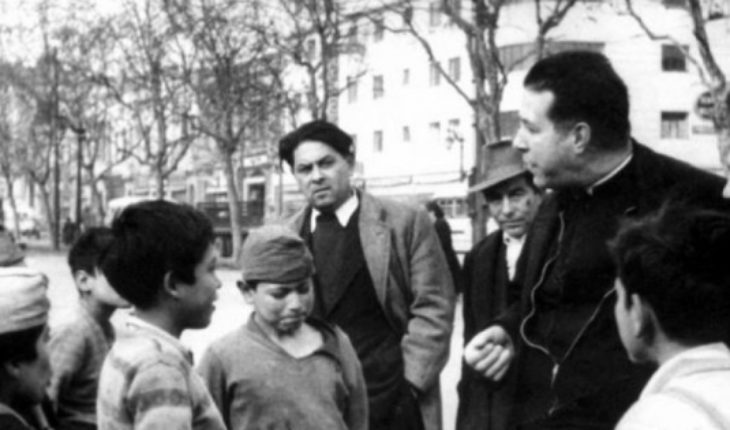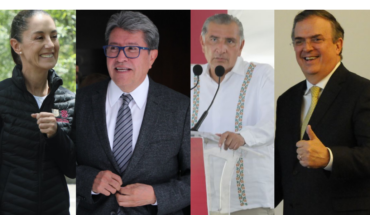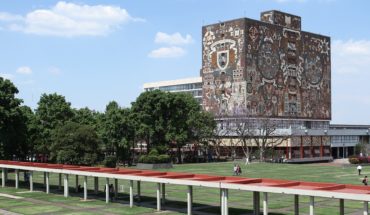“The question I’m going to ask is very complex, but many are asking today. To canonize a person there is an investigation that is very long and very thorough on the part of the Vatican, but thinking of this logic of being able to have clarity and to be able to continue venerating the figures that seem to be venerable, could one think of reinvestigating Alberto Hurt?.
The direct question asked at CNN Chile by the journalist Matilde Burgos , a former correspondent in the Vatican– ran the thick veil of a subject that for months has been quietly discussed in the corridors: the doubt of whether the first Chilean saint was completely oblivious to the crisis of abus that reminds you of the Catholic world and especially the Society of Jesus, to which he belonged.
Hours earlier, the outcome of the internal Jesuit investigation into Renato Poblete had been revealed and the results were shocking: at least 22 women who were victims of sexual abuse, cases of abortions and the use of financial means to commit the crimes. Poblete was one of the most well-known disciples of Alberto Hurtado, for years the face of the Home of Christ, and one of the main managers of his canonization in the 90s.
The delegate of the Jesuit provincial for the prevention of abuses, Francisco Jiménez, answered without hesitation to Burgos: “The Church (Catholic) does a canon investigation much more thorough than what we have done with Poblete. When you canonize someone, you do a process of years of research. I understand the discomfort, but I find it a little unfounded to attribute to Father Hurtado attitudes that have never appeared, there has never been any indication of anything like this.”
The consultation was the first, but not the only one. The next day, the priest Cristián del Campo, provincial of the Jesuits in Chile, had to answer on the same subject, and his reaction was annoyance: “I am not going to speak out about it, it seems to me a speculation that is unfair. If there is one person who has been investigated by a process of canonization and beatification in all areas of his life, it has been Father Hurtado,” he said.
Another point of view was Paulo Egenau, the social director of the Home of Christ. Interviewed by T13 Radio, he noted that “we have to take care of the general mistrust that the (Catholic) Church has generated. If there were reasons and fundamentals that would give rise to open an investigative look on Alberto Hurtado again, well, it will have to be done.”
Although in life he had many political and religious adversaries, and was a priest confessor to hundreds of children and young people both at the St. Ignatius school, in the Jesuit novitiate, and in the Home of Christ, no denunciation of the priest’s treatment about the priest’s treatment of is known at the time. and I had with them.
However, the debate does open up the analysis of his historical assessment, his way of exercising spiritual direction over the youth in his care, and how he handled cases of abuse of priests in his day. Unknown aspects of his legacy that show the lights and shadows of the “holy man”, as they call him in the multiple publications that tell his life on the way to the altars.
Three disciples
The most obvious subject that tarnishes Hurtado’s legacy (1901-1952) is that of his disciples. To date, at least three high-profile religious directly linked to the priest have been involved in serious cases of sexual abuse. The most recent is Poblete (1924-2010), one of his followers among the youth of Catholic Action, the powerful Christian youth organization that led the canonized priest in the 1940s.
“My vocation was born as a ‘conversation’, meeting Father Hurtado and working close to him in Catholic Action. It wasn’t a slob, but I gradually matured,” he recounted in a 1997 interview with Caras magazine. In another interview, two years later, he added more details: “He was a rather sloppy, very rebellious child. In a way, I became Father Hurtado. I had a total free life and he was convincing me that the ladies had to be respected, that we had to calm down more calmly.”
Poblete entered the Society of Jesus urged by the priest and, eventually, for almost 20 years, was chaplain of the Home of Christ. According to the report filed last week by the lay lawyer Waldo Bown, the priest has been abusing it since 1960.
The other case is that of deacon Hugo Montes Brunet, National Education Award 1995, who has written several books on the Jesuit saint. He was a friend and disciple of Hurtado from 1941, when they met in retirement, and was under his spiritual direction for 10 years.
In the process of canonization of Hurtado, quoted by the Jesuits, 60 sworn testimonies of people who knew the priest in life and can account for his “heroic virtues”, a requirement to become a saint of the Catholic Church are collected. Hugo Montes Brunet’s is the 16th testimony of that process.
In the same document – called Positio Super Virtutibus (Position On Virtues), published in Rome in 1987 – the 10th testimony for the sanctification of Hurtado corresponds to that of Fernando Karadima Fariña. The Exparagus of The Forest was expelled from the priesthood in September 2018 for several cases of sexual abuse and conscience against youth. In 31 veneers, Karadima recounts several experiences shared between 1948 and 1952 with Hurtado, who was the spiritual director who motivated him to enter the priesthood. And, in fact, a scene from the miniseries “Chronicle of a Holy Man” – which aired Channel 13 in 1990 and where the actor Cristián Campos played the role of Hurtado – recreates a supposed situation where the founder of the Home of Christ and Karadima rescue children on the Mapocho River.
It was no coincidence: Karadima’s inclusion as a character in the series would have been suggested by Renato Poblete.
“Moral pressure”
His ascendancy of young people was legendary: in his time he managed to consecrate about 70 Jesuit priests. However, there were those who questioned his recruitment methods.
Of the 60 testimonies collected by the canonization process (among those of Karadima, Hugo Montes, Archbishop emeritus Bernardino Piñera, and the late bishops Carlos González, Eladio Vicuña and Alejandro Huneeus), there is one who refuses to make Alberto Hurtado declared a saint. It is the doctor and university professor Hernán Cuevas Ramírez, now deceased, who in the document criticizes the “moral pressure” that as spiritual director the priest would have exerted on young people.
According to the unpublished document, “On the scarcity of clergy that he believed to see in Chile, Father Hurtado began a campaign for priestly vocations, especially in schools that depended on the Order of St. Ignatius. Father Hurtado’s approaches were of such a nature that, deep down, for a boy between the ages of 14 and 17, belonging to a Catholic family, he had no choice but the choice of priestly or religious life. I believe that Hurtado taxed the consciences of young people in an exaggerated and undue way. Ultimately exerting a moral pressure that the young man found very difficult to ignore. I know that a novice who is currently a surgeon, Dr. Rosselot, fled the novitiate by jumping the walls of the property, as the only way to subtract from the almost uncounterrestable influence of Father Hurtado.”
In the final report for the canonization prepared in the Vatican, they include the testimony of Dr. Cuevas, but dismiss his criticisms.
Several biographies coincide in highlighting Hurtado’s charismatic and influential style, achieving as national advisor to Catholic Action to join hundreds of young people for the organization, with whom he paraded through the streets of Santiago.
Within Catholic Action he created a select group called the Service of Christ the King, as he said, by those outstanding young men who “aspire to fully develop their faith and accept all the sacrifices brought by the apostolate”. Hurtado used to be surrounded by twenty young people, mainly teenagers, entourage that accompanied him to spiritual exercises in a house located in the commune of Morocco (now the commune of Padre Hurtado) or walks on the outskirts of Santiago.
As spiritual director, Hurtado’s routine was to receive his disciples every fortnight in his office, which was also his room, and where, according to accounts of the time, he had images of these young men. As the priest José Correa recounted in the documentary Journey to the Soul of a Holy Man, “in the piece of him there is a collection of photographs of many of those of us who went to vocations of him, he would tell us, when we were going to enter, take a photograph and give it to me. We called him the gallery of martyrs.”
In a biographical review of Hurtado, written by Renato Poblete himself, he said: “He said that a relationship of sympathy must be established between the teacher and the disciple, so that he is a kind of father or older brother. At the age of 35 Father Hurtado met the boys aged 16 and 17, with a soul capable of vibrating with the same concerns as them, so that it was very easy for him to give him all their trust and friendship. It was very easy for this already intellectually mature priest and man to exert a powerful influence. With vigorous and virile rudeness, he appealed to the sense of honor.”
Youth sexuality books
The religious was not the only facet of the young people that interested the priest. Lawyer of the Catholic University, with studies in pedagogy and psychology in Levaina, Belgium, Hurtado has been left in history for his charitable work and social discourse.
However, much of the books he wrote are about another topic that mattered to him: adolescent sexuality, an issue he used to deal with in talks and retreats with his students, focusing on the importance of chastity. Works that have been left in the background in his biography, but that gain relevance today to understand his thinking and relate to his close ones. Biographers of Father Hurtado stress that in addressing these matters he was ahead of his time, when sexuality was still a taboo subject.
In his book The Affective Life of Adolescence (1938), he addresses the sublimation of sexual impulses and titles chapter fourth “Affective Relationships between Adolescents and People of Different Ages”. There, he notes that this relationship is not “sick” when given on a spiritual level: “Another form there is of affectivity between people of different age that does not offer the dangers of the former. It’s a spiritual love. The older person searches for the younger person to give something that this lacks and this in turn offers the older person the native purity that no longer possesses. The oldest would like to guide the teenager. The half-numbed and naively receptive young soul unconsciously seeks the strong soul concentrated in a direction and therefore dominating. An approach from the adult to the young stere so that both are completed in the platonic direction. This affection so that it can be safely developed requires that the persons concerned do not in themselves offer anything reprehensible and that the education of the chastity of the greatest has been carried out properly”.
In another of his books, The Crisis of Puberty and the Education of Chastity (1945), he develops in detail the physical and psychological changes that the child experiences in puberty, and makes a defense of maintaining virginity until marriage and impulse control is xuales. He also argues that parents should talk to children at an early age about these issues as soon as they ask the first questions about gestation. “Of course, if the realization of this duty is a very heavy burden for them, the doctor, the educator, and above all the priest may be the counselors in which the parents discharge this responsibility. The teaching priest, spiritual father, or confessor at a school seem the most suitable to replace parents,” he says.
Controversy and handling of accusations
Hurtado’s influence on young people began to make the authorities of the Catholic Church, especially Bishop Augusto Salinas, uncomfortable until he forced his resignation as national adviser to Catholic Action in 1944. Among the accusations – and of which he defended himself at length – were those of politicizing the movement and of not respecting the hierarchy.
Jaime Castellón’s book Cartas de San Alberto Hurtado (s.j.) shows the existence of other less-known accusations. One for the occurrence of alleged sexual themes in the group, before which, Hurtado, in a letter to Archbishop José María Caro of December 1, 1944, responds: “Sexual initiation. It has been claimed that it has been done in our Branch. I haven’t figured out a single case for more research.” Although no details are provided, the priest’s biographers explain that the case may relate to initiation in sex education, a subject to which he devoted part of his books.
Another accusation against him, and that details are also omitted, is because of the defense that made a priest sanctioned by The Vatican. Hurtado wrote: “The suspended priest’s affair. I believed in the duty to reach out to him for the relief of his soul, I spoke to his superiors asking them to lift his suspension while the response from Rome arrived. I did not organize the medical defense but Don Carlos Casanueva spontaneously spoke to the priest of his moral situation. I intervened on behalf of the priest because I have seen a soul in danger of eternal doom.”
It is the writer Jorge Edwards, National Prize for Literature 1994, who gives further clues about how Alberto Hurtado responded when he heard a case of sexual abuse. Edwards revealed, in a 2012 interview, that the priest Eduardo Cadiz of the San Ignacio school sexually abused him when he was 11 years old. But he managed to cope with the drama thanks to Alberto Hurtado. “The only interesting thing is that Father Alberto Hurtado, who was a great character, made going to that Band-Aid from the school,” the writer said at that time, adding that Hurtado had a more relaxed style, as he allowed fourth-year students to smoke in the Breaks. However, years later, in 2018, this time in an interview on Radio Zero, Edwards was more critical about how Hurtado handled the situation, explaining that what had been done was something that would be very much questioned today: a move of the priest to another place.
“And, well, spinster priests with so much little boy. I counted in my first volume of memoirs a case that Hurtado solved lousy lynously. My older brother went to tell Father Hurtado that this father, little Cadiz, when I got sick, came to the house and sat on the bed and well… and what they did with Father Cadiz is that they moved him to a school in Puerto Montt. Father Cadiz liked the footballers at the school, and one day I opened the social pages of Zig Zag and there was the football team of the Jesuit school of Puerto Montt and, in the middle, Cadiz,” he said.
The patronocytes
Perhaps the facet that has remained most in the collective imagination is that of the priest in his emblematic “green van”, working full-time for those he called his “patroncitos”. Hurtado devoted his final years to obtaining resources to help street children and also homeless adults. A common drama in a Chile where poverty was soaring. The situation of misery of the children living on the banks of Mapocho was embodied in Alfredo Gómez Morel’s autobiographical novel, El Río (1962), who in the text recounts that he was repeatedly abused by two Catholic priests who were going to seek him to the river in the 1930s.
The author, who died in 1984, stated in an interview in Paula Magazine that, some time later, he met Alberto Hurtado, who offered to go to the Home of Christ, and accepted despite his distrust of the priests. “Come with me. If you want to give me your name, do it. But it doesn’t matter what your name is. I want to help you,” he told her, according to Gomez Morel’s account.
“He was a saint before I was holy, I burnmy hands for him. I am shocked that they want to investigate Father Hurtado, talk to anyone who graduated from the Home, they will never find anything”, argues José Palma, the “Palmita”, today 81 years old and one of the first guests of the Home of Christ. His testimony is also in the process of canonization: he is a grateful priest and reaffirms the priest’s best-known profile.
“They were the priests of before. One would call them ‘father, give me a medal’ and take the medal from under the socks. The priests of now have no vocation and are spoiled in the seminary. The priests of the former walked with their sand as the priests have to walk, as Father Hurtado and father (Alvaro) Lavín, a close friend of his, with which he did military service and between the two founded the Home of Christ,” he recounts.
He says he was not more than 8 years old on a winter night when, covered with newspapers and accompanied by other children and stray dogs, he tried to sleep in Central Station. Hurtado arrived in his van to look for them. “We used to call him the vampire, because of his huge teeth and because he was so big.” According to his testimony, “he told us, “Do you want to go to a new house that I have? It was my salvation, because I had nothing (…). We got in the van and we got a blanket, we had to sleep upstairs because it was full. The next day they took us out, bathed us and cut our hair.”
According to the testimonies compiled in the book about his work, A Fire That Ignites Other Fires (2004), Father Hurtado “drove very fast, with very sharp braking when he thought he saw a child lying in the street, to pick him up, that lasted from 10 p.m. to 3 p.m. morning” (Mary Opazo). “We stopped on the banks of the Mapocho River and he explained to me the strategy he used to approach lazy children without scaring them. He was glowing with joy when he told me about one of them who had learned a trade” (P. Le Roy, s.j.) The green ford van from year 46, in any case, had a rule that today could be questioned: they could not climb women. “I remember on one occasion I asked him to take me in his van to the railway station. The father answered me, you will forgive me but I never take a lady in my van, take a taxi and I cancel it,” Carmen Cabieses, former collaborator of the Home of Christ, said in the canonization report.
According to José Palma, there are currently no more than 30 “patroncitos” left alive who were rescued by Alberto Hurtado – “last year three died”–, who meet all August 18 at a mass in the parish Jesus Obrero, next to the Home of Christ, on the anniversary of the saint’s death.
He continued to work as an auxiliary for more than 30 years in the Home of Christ, and does not believe in the allegations against Renato Poblete: “For me those are a trace of liars, they want money. I’m never going to believe it,” he says.
He’s one of the few. The general reaction has been of such a condemnation that the shards have splattered the figure of his mentor, even without any specific accusations or complaints. This Sunday, Waldo Bown himself, the lawyer who carried out the inquiry, responded bluntly in La Tercera: “In none of the investigations I have had to process I have reached the smallest detail, rumor or antecedantelate of some misconduct of Father Alberto Hurtado. None.”
But probably the one who best reflected the new climate of opinion in the face of Jesuit abuses, was national prosecutor Jorge Abbott, who after receiving Bown’s executive summary on P’s casewafer – 30 pages of the report’s more than 400 – the press said on Thursday that it is investigating 10 people linked to the Society of Jesus and that it could not rule out extending the inquests to Alberto Hurtado. His words were clear: “The Public Prosecutor’s Office never dismisses any line of inquiry. Of course, it’s been many years, but it may be important to open investigative lines in this regard.”
The content poured into this opinion column is the sole responsibility of its author, and does not necessarily reflect the editorial line or position of El Mostrador.





